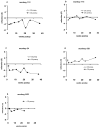Accommodative lens refilling in rhesus monkeys
- PMID: 16799042
- PMCID: PMC2918258
- DOI: 10.1167/iovs.05-1346
Accommodative lens refilling in rhesus monkeys
Erratum in
- Invest Ophthalmol Vis Sci. 2006 Aug;47(8):3246. Vilipuru, Abhiram S [corrected to Vilupuru, Abhiram S]
Abstract
Purpose: Accommodation can be restored to presbyopic human eyes by refilling the capsular bag with a soft polymer. This study was conducted to test whether accommodation, measurable as changes in optical refraction, can be restored with a newly developed refilling polymer in a rhesus monkey model. A specific intra- and postoperative treatment protocol was used to minimize postoperative inflammation and to delay capsular opacification.
Methods: Nine adolescent rhesus monkeys underwent refilling of the lens capsular bag with a polymer. In the first four monkeys (group A) the surgical procedure was followed by two weekly subconjunctival injections of corticosteroids. In a second group of five monkeys (group B) a treatment intended to delay the development of capsular opacification was applied during the surgery, and, in the postoperative period, eye drops and two subconjunctival injections of corticosteroids were applied. Accommodation was stimulated with carbachol iontophoresis or pilocarpine and was measured with a Hartinger refractometer at regular times during a follow-up period of 37 weeks in five monkeys. In one monkey, lens thickness changes were measured with A-scan ultrasound.
Results: In group A, refraction measurement was possible in one monkey. In the three other animals in group A, postoperative inflammation and capsular opacification prevented refraction measurements. In group B, the maximum accommodative amplitude of the surgically treated eyes was 6.3 D. In three monkeys the accommodative amplitude decreased to almost 0 D after 37 weeks. In the two other monkeys, the accommodative amplitude remained stable at +/-4 D during the follow-up period. In group B, capsular opacification developed in the postoperative period, but refraction measurements could still be performed during the whole follow-up period of 37 weeks.
Conclusions: A certain level of accommodation can be restored after lens refilling in adolescent rhesus monkeys. During the follow-up period refraction measurements were possible in all five monkeys that underwent the treatment designed to prevent inflammation and capsular opacification.
Figures






Similar articles
-
Accommodation amplitudes after an accommodating intraocular lens refilling procedure: in vivo update.J Cataract Refract Surg. 2014 Feb;40(2):295-305. doi: 10.1016/j.jcrs.2013.06.028. J Cataract Refract Surg. 2014. PMID: 24461501 Free PMC article.
-
Prevention of capsule opacification after accommodating lens refilling: pilot study of strategies evaluated in a monkey model.J Cataract Refract Surg. 2014 Sep;40(9):1521-35. doi: 10.1016/j.jcrs.2014.02.034. J Cataract Refract Surg. 2014. PMID: 25135545
-
Changes in lens stiffness due to capsular opacification in accommodative lens refilling.Exp Eye Res. 2015 May;134:148-54. doi: 10.1016/j.exer.2015.02.015. Epub 2015 Feb 19. Exp Eye Res. 2015. PMID: 25704214
-
Lens refilling to restore accommodation.J Cataract Refract Surg. 2009 Feb;35(2):374-82. doi: 10.1016/j.jcrs.2008.10.054. J Cataract Refract Surg. 2009. PMID: 19185257 Review.
-
Accommodating intraocular lenses: a critical review of present and future concepts.Graefes Arch Clin Exp Ophthalmol. 2007 Apr;245(4):473-89. doi: 10.1007/s00417-006-0391-6. Epub 2006 Aug 30. Graefes Arch Clin Exp Ophthalmol. 2007. PMID: 16944188 Review.
Cited by
-
Age-Related Changes to the Three-Dimensional Full Shape of the Isolated Human Crystalline Lens.Invest Ophthalmol Vis Sci. 2020 Apr 9;61(4):11. doi: 10.1167/iovs.61.4.11. Invest Ophthalmol Vis Sci. 2020. PMID: 32293664 Free PMC article.
-
Long-term prevention of capsular opacification after lens-refilling surgery in a rabbit model.Acta Ophthalmol. 2019 Sep;97(6):e860-e870. doi: 10.1111/aos.14096. Epub 2019 Mar 22. Acta Ophthalmol. 2019. PMID: 30900825 Free PMC article.
-
Changes in crystalline lens radii of curvature and lens tilt and decentration during dynamic accommodation in rhesus monkeys.J Vis. 2008 Jan 28;8(1):18.1-12. doi: 10.1167/8.1.18. J Vis. 2008. PMID: 18318621 Free PMC article.
-
Topical and intravenous pilocarpine stimulated accommodation in anesthetized rhesus monkeys.Exp Eye Res. 2010 May;90(5):605-16. doi: 10.1016/j.exer.2010.02.005. Epub 2010 Feb 14. Exp Eye Res. 2010. PMID: 20159011 Free PMC article.
-
Role of the lens capsule on the mechanical accommodative response in a lens stretcher.Invest Ophthalmol Vis Sci. 2008 Oct;49(10):4490-6. doi: 10.1167/iovs.07-1647. Epub 2008 May 30. Invest Ophthalmol Vis Sci. 2008. PMID: 18515568 Free PMC article.
References
-
- Von Helmholtz H. Ueber die Akkommodation des Auges. Albrecht von Graefes Arch Klin Ophthalmol. 1855;1:1–74.
-
- Glasser A, Campbell MCW. Presbyopia and the optical changes in the human crystalline lens with age. Vision Res. 1998;38:209–229. - PubMed
-
- Soergel F, Meyer C, Eckert G, et al. Spectral analysis of viscoelasticity of the human lens. J Refract Surg. 1999;15:714–716. - PubMed
-
- Koopmans SA, Terwee T, Barkhof J, Haitjema H, Kooijman AC. Polymer refilling of presbyopic human lenses in vitro restores the ability to undergo accommodative changes. Invest Ophthalmol Vis Sci. 2003;44:250–257. - PubMed
MeSH terms
Substances
Grants and funding
LinkOut - more resources
Full Text Sources
Other Literature Sources

